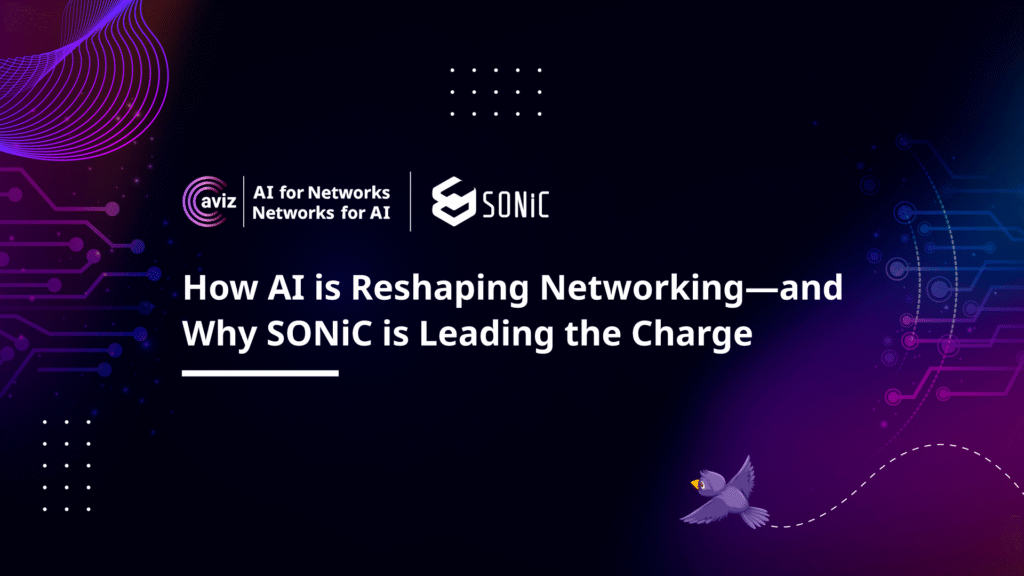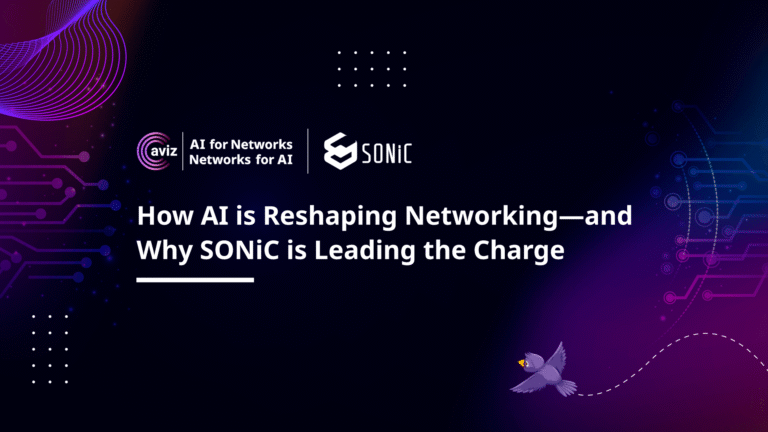A Conversation with Vishal Shukla, CEO of Aviz Networks
In a recent conversation, Alan Weckel of the 650 Group sat down with Vishal Shukla, Co-founder and CEO of Aviz Networks, to discuss the evolution of open networking, the growing maturity of the SONiC ecosystem, and how artificial intelligence is redefining both network infrastructure and operations. Here are the key insights from that conversation.
What Is Aviz Networks and Why Does It Matter in AI Networking?
"We are creating a network software stack, end to end, in two dimensions — Networks for AI and AI for Networks. That means building networks that support AI workloads, and using AI to make networks smarter."
Vishal Shukla, CEO, Aviz Networks
Aviz Networks builds a full-stack, vendor-agnostic platform for open networking and AI-powered automation. At the center is ONES (Open Networking Stack), which provides a unified control and observability layer across NOS platforms like SONiC and NVIDIA Spectrum-X.
This approach gives enterprises the flexibility to scale their infrastructure while maintaining operational consistency—whether they’re deploying AI workloads at the edge or automating compliance in the data center.
How Is Aviz Executing on Its Vision for Open Networking?
Over the past two years, Aviz has transitioned from vision to deployment by building a fully integrated, AI-ready networking stack:
- 2023–2024: Standardized SONiC integration for vendor-agnostic networks
- Late 2024: Introduced deep visibility and telemetry tools for real-time observability
- 2025: Launched Network Copilot, an AI assistant that enables proactive, data-driven network automation
Today, Aviz is deploying its stack across 15 verticals, including healthcare, telco, e-commerce, and retail—proving that open networking and AI networking are enterprise-ready.
Why Is SONiC Adoption Accelerating in Retail and Edge Use Cases?
Retail has become a standout use case for SONiC adoption, especially at the edge. Originally designed for hyperscale data centers, SONiC has now been extended to store-level and branch environments through the Aviz-led PENCE initiative (POE Edge Networks with SONiC).
Edge networks in retail demand:
- High availability with minimal complexity
- Low cost of operation
- Real-time visibility into remote locations
SONiC’s lightweight, scalable architecture—combined with Aviz’s enhancements—makes it an ideal fit for these needs.
How Has SONiC’s Evolution Prepared It for Enterprise-Scale Network Automation?
SONiC has evolved into a production-grade solution for network operators across industries. According to Vishal, this evolution spans three dimensions:
- Protocols: Support for IP CLOS, EVPN, VXLAN, and edge features now covers 80% of enterprise use cases.
- Enterprise Readiness: Faster patching and microservices architecture enable quick responses to security vulnerabilities (e.g., OpenSSL CVE fix within 3 weeks).
- Deployment Maturity: Proven use across healthcare, telco, and retail verticals—with or without Aviz—validates SONiC’s scalability and flexibility.
This evolution positions SONiC as a core enabler of AI networking and next-gen network infrastructure.
How Is the SONiC Ecosystem Growing Around Open Networking?
As enterprise needs grow more complex, the SONiC ecosystem is expanding to include:
- Orchestration and automation layers
- Real-time observability and SLA monitoring
- Integration with SecOps and NetOps tools
- 24/7 enterprise support
- Security and compliance frameworks
Aviz is actively building the controller layer around SONiC through its ONES platform—tying together telemetry, automation, and AI to provide a turnkey solution for open networking at scale.
What Role Does SONiC and ONES Play in Networks for AI?
As AI workloads scale, enterprises need flexible, high-bandwidth fabrics. Two deployment models are emerging:
- NVIDIA Spectrum-X for vertically integrated AI environments
- SONiC-based fabrics for open, customizable deployments
Aviz’s ONES platform supports both approaches—providing a consistent operational interface across front-end and back-end networks. In Vishal’s words:
“In this world where the infrastructure is changing very fast... you need to standardize your operating layer.”
Vishal Shukla, CEO, Aviz Networks
By decoupling the control plane from the underlying hardware, Aviz allows customers to support 400G, 800G, and 1.6T environments—future-proofing the network for accelerated AI innovation.
How Does AI for Networks Drive Real-World Network Automation?
AI for Networks is all about applying intelligence to daily operations. Aviz Network Copilot is designed to automate routine NetOps workflows through vendor-agnostic, privacy-preserving AI:
- Compliance Checks – Continuously monitor configuration, security, and operational compliance
- Audit Report Generation – Use generative AI to create structured documentation
- Playbook Standardization – Ensure team-wide consistency in automation scripts
- Toolchain Integration – Connect to JIRA, ServiceNow, Zabbix, and other NetOps tools
By embedding network automation into everyday workflows, Copilot reduces manual effort and enables teams to focus on strategic tasks.
“It’s like a human network engineer—AI must be vendor-agnostic and understand the full stack.”
Vishal Shukla, CEO, Aviz Networks
What’s an Example of Network Copilot in Action?
In one customer deployment, each engineer was writing their own Ansible playbooks—resulting in fragmented automation. With Network Copilot, Aviz enabled:
- Standardization of scripting formats
- Role-based customization
- Automated playbook generation with AI-assisted validation
This use case demonstrates how AI can enable repeatable, secure, and scalable network automation.
What’s Next for AI Networking in 2025?
Aviz is doubling down on two fronts:
1. Scaling SONiC and Open Networking for AI Workloads
- Broaden ONES + SONiC + Spectrum-X deployments across all 15 verticals
- Continue expanding SONiC’s feature set for edge and AI fabric use cases
2. Defining AI’s Role in Network Automation
- Identify 10–20 repeatable use cases for Network Copilot
- Validate these use cases across real-world customer environments
- Refine agent-based orchestration for NetOps and SecOps workflows
The end goal? A new standard for how enterprise networks are designed, operated, and automated.
Explore Aviz ONES and Network Copilot
- Learn more about ONES
- Discover Network Copilot
Frequently Asked Questions
AI Networking, SONiC Adoption, Open Networking, and Network Automation
1. What is SONiC, and how does it support AI Networking?
SONiC (Software for Open Networking in the Cloud) is an open-source network operating system originally developed by Microsoft. It’s now widely used by enterprises to build vendor-agnostic, high-performance network infrastructure.
SONiC enables flexibility, scalability, and cost savings—making it ideal for supporting AI workloads across data centers and edge environments. Its modular architecture allows integration with platforms like Aviz ONES, providing full-stack support and observability.
2. How does Aviz Network Copilot power Network Automation?
Network Copilot is an AI-driven assistant that automates everyday NetOps tasks. It continuously monitors network health, flags compliance issues, and generates audit reports using generative AI.
Unlike traditional tools, it is vendor-agnostic, integrates with JIRA, ServiceNow, and Ansible, and can operate in on-prem environments for full data privacy. It’s built to scale across multi-vendor environments, making it ideal for enterprises looking to adopt intelligent, secure network automation.
3. What makes Aviz ONES different from traditional network controllers?
ONES is a vendor-neutral operating layer that connects SONiC, NVIDIA Spectrum-X, and third-party observability and orchestration tools. It supports real-time telemetry, SLA enforcement, and multi-domain visibility, all while preserving the open-source nature of SONiC.
What makes it unique is its ability to serve as a single control point for Networks for AI—handling both backend AI fabric and frontend application layers.
4. How mature is SONiC for enterprise adoption today?
SONiC has significantly matured across protocols, enterprise readiness, and ecosystem support. It now supports IP CLOS, EVPN, VXLAN, and edge features—covering 80%+ of enterprise use cases.
Security responsiveness has improved thanks to its microservices model, and deployments span industries like healthcare, retail, telco, and e-commerce. With vendors like Aviz providing support, observability, and controller layers, SONiC is ready for mainstream enterprise use.
5. How does AI make network operations more efficient?
AI improves operational efficiency by offloading mundane, repetitive tasks—like config validation, compliance checks, and documentation generation. Tools like Network Copilot act as co-pilots, helping network engineers troubleshoot faster, enforce standards, and reduce human error.
The key? It’s agentic—meaning it doesn’t just analyze data, but also triggers workflows, integrates with automation pipelines, and adapts to unique infrastructure setups.




